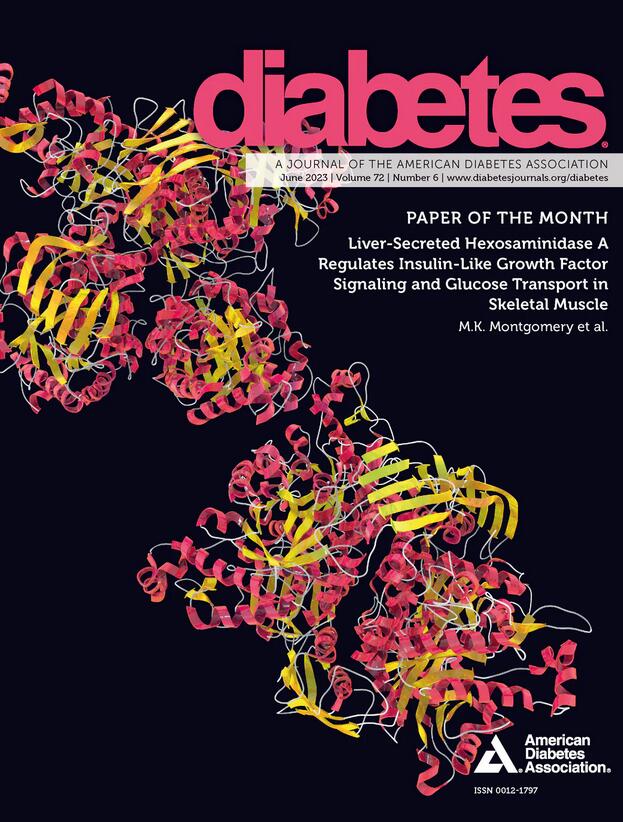1552-P:具有残余 CFTR 功能的突变与囊性纤维化患者更好的葡萄糖耐受性和胰岛素分泌有关
IF 6.2
1区 医学
Q1 ENDOCRINOLOGY & METABOLISM
引用次数: 0
摘要
囊性纤维化患者(pwCF)表现出胰岛素分泌缺陷[1],可能导致囊性纤维化相关糖尿病。关于胰岛素分泌缺陷与 CFTR 基因致病变体之间的分子机制[2,3],目前几乎没有任何信息。我们试图描述 CFTR 功能与 pwCF 中 β 细胞功能之间的关系。我们对 341 名患者(193 名(57%)女性,271 名(79%)胰腺功能不全,中位数(IQR)年龄 19(15,24)岁)进行了口服葡萄糖耐量试验(OGTT),在 2 小时 OGTT 之前和 2 小时 OGTT 期间每隔 30 分钟采集葡萄糖、胰岛素和 C 肽的样本,通过 β 细胞葡萄糖敏感性来模拟 β 细胞功能[4]。每位患者的特征是至少有一个等位基因存在残余功能突变(第 1 组,85 例(25%)),或两个等位基因都存在最小功能突变(第 2 组,255 例(75%))。在对性别、胰腺功能不全(PI)和年龄进行调整后,第1组患者在所有OGTT时间点的葡萄糖耐量均较好(所有p=<0.05),β细胞葡萄糖敏感性较好(22 pmol×min-¹×m-²×m-¹; 95% CI 9.6, 34; p=<0.001)。在整个样本中,162 名患者(82 名(51%)女性,136 名(84%)第 2 组患者,139 名(86%)胰腺功能不全患者,中位(IQR)年龄为 20(15,25)岁)的两个等位基因上都携带变体,这些变体已在费舍尔大鼠甲状腺细胞系(http://cftr2.org)中进行了氯传导测试。功能最强等位基因的平均氯离子传导率与β细胞葡萄糖敏感性呈正相关(0.96;95% CI 0.13,1.8;p=0.025),无PI交互作用(交互作用项-0.63;95% CI -3.7,2.4;p=0.7),并调整了性别和年龄差异。总之,我们已经证明,CFTR 功能与 pwCF 中的β细胞功能有定量关系。尽管外分泌 PI 与较差的 β 细胞功能有关,但 CFTR 残余功能与 β 细胞葡萄糖敏感性之间的关联并不一定是由外分泌 PI 介导的。披露 A. Foppiani:无。F. Ciciriello: 无。F. Alghisi:无。V. Lucidi:无。F. Sileo:无:无。M. Lucanto:无。F. Corti:无。C. Colombo:无。A. Battezzati:无。资助 囊性纤维化研究基金会 FFC#16/2005、FFC#21/2013、FFC#20/2016 和 FFC#24/2019本文章由计算机程序翻译,如有差异,请以英文原文为准。
1552-P: Mutations with Residual CFTR Function Are Associated to Better Glucose Tolerance and Insulin Secretion in Patients with Cystic Fibrosis
People with Cystic Fibrosis (pwCF) exhibit a defect of insulin secretion[1], potentially leading to Cystic Fibrosis Related Diabetes. Little information exists about the molecular mechanism that links the defect of insulin secretion to the CF-causing variants of the CFTR gene[2,3]. We sought to describe the relationship between the CFTR function and β-cell function in pwCF. We studied 341 patients (193 (57%) females, 271 (79%) pancreatic insufficient, median (IQR) age 19 (15, 24) years) with the oral glucose tolerance test (OGTT), sampling glucose, insulin, and C-peptide before and every 30 minutes over the 2 hour OGTT, modeling β-cell function expressed by the β-cell glucose sensitivity[4]. Each patient was characterized by either having at least one allele with a residual function mutation (group 1, 85 (25%)), or a minimal function mutation on both alleles (group 2, 255 (75%) ). After adjusting for sex, pancreatic insufficiency (PI), and age, patients in group 1 displayed better glucose tolerance at all OGTT timepoint (all p=<0.05), and better β-cell glucose sensitivity (22 pmol×min⁻¹×m⁻²×mM⁻¹; 95% CI 9.6, 34; p=<0.001).Within the whole sample, 162 patients (82 (51%) females, 136 (84%) of group 2, 139 (86%) pancreatic insufficient, median (IQR) age 20 (15, 25) years) carried variants on both alleles that had been tested for chloride conductance in the Fischer Rat Thyroid cell line (http://cftr2.org). The mean chloride conductance of the most functional allele was positively related to β-cell glucose sensitivity (0.96; 95% CI 0.13, 1.8; p=0.025), with no PI interaction (interaction term -0.63; 95% CI -3.7, 2.4; p=0.7), and adjusting for differences in sex and age. In conclusion, we have shown that CFTR function is quantitatively related to β-cell function in pwCF. Even though exocrine PI is associated with worse β-cell function, the association of CFTR residual function and β-cell glucose sensitivity is not necessarily mediated by exocrine PI. Disclosure A. Foppiani: None. F. Ciciriello: None. F. Alghisi: None. V. Lucidi: None. F. Sileo: None. M. Lucanto: None. F. Corti: None. C. Colombo: None. A. Battezzati: None. Funding Cystic Fibrosis Research Foundation FFC#16/2005, FFC#21/2013, FFC#20/2016, and FFC#24/2019
求助全文
通过发布文献求助,成功后即可免费获取论文全文。
去求助
来源期刊

Diabetes
医学-内分泌学与代谢
CiteScore
12.50
自引率
2.60%
发文量
1968
审稿时长
1 months
期刊介绍:
Diabetes is a scientific journal that publishes original research exploring the physiological and pathophysiological aspects of diabetes mellitus. We encourage submissions of manuscripts pertaining to laboratory, animal, or human research, covering a wide range of topics. Our primary focus is on investigative reports investigating various aspects such as the development and progression of diabetes, along with its associated complications. We also welcome studies delving into normal and pathological pancreatic islet function and intermediary metabolism, as well as exploring the mechanisms of drug and hormone action from a pharmacological perspective. Additionally, we encourage submissions that delve into the biochemical and molecular aspects of both normal and abnormal biological processes.
However, it is important to note that we do not publish studies relating to diabetes education or the application of accepted therapeutic and diagnostic approaches to patients with diabetes mellitus. Our aim is to provide a platform for research that contributes to advancing our understanding of the underlying mechanisms and processes of diabetes.
 求助内容:
求助内容: 应助结果提醒方式:
应助结果提醒方式:


